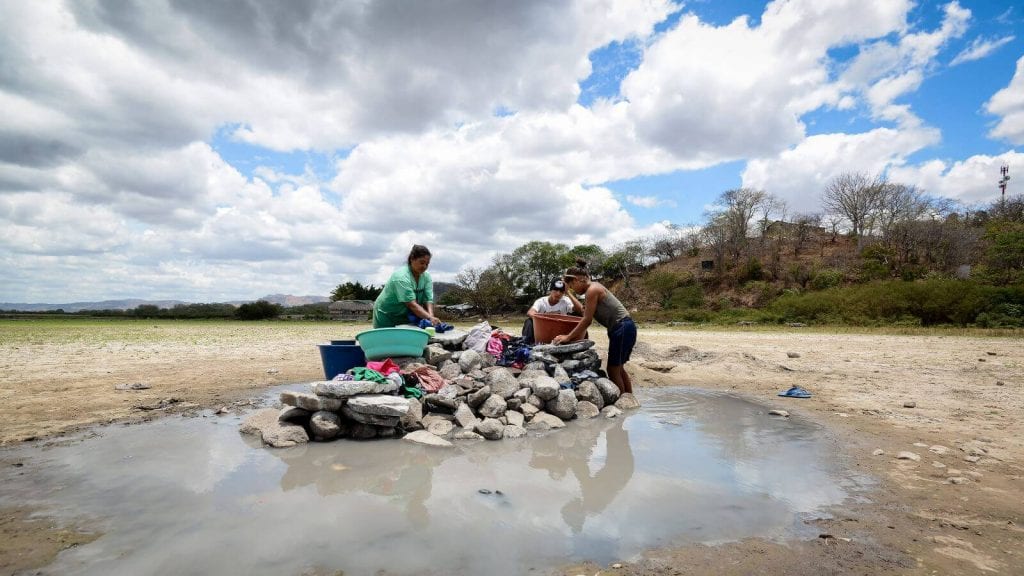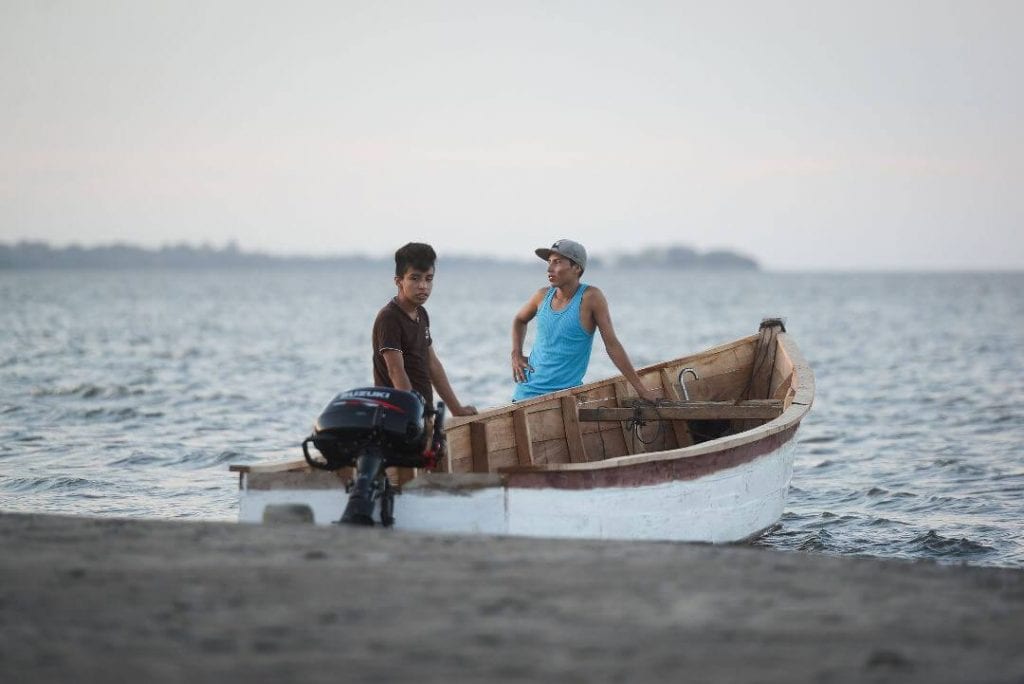SOS for Nicaragua’s Great Lake
By Maynor Salazar (Confidencial)

HAVANA TIMES – Residents of the communities around Lake Cocibolca (Lake of Nicaragua) share the same concern: the water level of the lake is dropping and they fear that “climate change” will dry it up completely, as happened to the Tisma wetlands and to the dam at Las Canoas.
“The water in the lake has retreated some 50 meters from the coast in six months. We used to wash clothes at the edge, but today we have to follow the water. Every day it retreats further, and that worries us,” says María Lidia Obando, a native of Puerto Diaz near the town of Juigalpa in Chontales department.
Farmers from the island of Ometepe also spoke of their situation. In the last few months the water level had drawn back ever further from the coast and their small boats are left mired in the mud.
“We’re plantain producers and we have a problem getting our product out. We run aground several meters before reaching the cities on the mainland,” Maynor Ortiz of the island of Ometepe states, worried. “This affects us, since we have to hire more people because you have to walk more.”
People who fish have to go out longer distances. “We’ve been fishing all our lives, but now it’s more work to obtain the product. The fish leave because the lake is drying and we have to go further out and take more time getting back. This is critical,” fisherman Alvaro Téllez assures us.
Citizens blame climate change and place their hopes on the upcoming rainy season being better, with abundant rain. The experts are less optimistic: they point out other factors that work against the high hopes of a country that is beginning to feel thirsty.
Fabio Buitrago, biologist and ecologist, explains that deforestation in the zone around the lakeshore has caused more sediment to accumulate in Cocibolca. This deforestation also keeps the water from filtering through and feeding the groundwater, so its level decreases.
“The water you see is just the mirror, the surface. You’d say that the lake hasn’t changed much, maybe just the color very slightly. But if we could look vertically, the quantity of mud that accumulates every year makes for less vertical distance. What happened with the Tisma lagoon is that we came to have a column of water so small and so shallow that it evaporated. This is what will probably happen to Xolotlán (Lake of Managua) as well, and it’s something that Cocibolca isn’t exempt from either.” Buitrago explains.
Cocibolca at risk
The people who depend on Cocibolca are witnesses to how the lake’s volume has diminished in the last six months. Despite this, experts like Buitrago affirm that the government doesn’t have exact data on the volume of water that’s been lost. “It’s a fact that’s its level has dropped, because of sedimentation, because of the disproportionate use of its water for agriculture, but there’s no hard information about the damage the lake is suffering,” Buitrago affirms.
Salvador Montenegro, expert in hydrological resources, adds that the fact of having allowed or encouraged deforestation, unsustainable agriculture and extensive cattle-raising has generated a process of desertification that can’t be corrected only by reforestation, since more actions are needed.

“The simple existence of forests in the higher part of the watershed, even without rain, is usually enough to capture the atmospheric humidity and condense it, so that it filters drop by drop into the ground. But with the disappearance of the cloud forests, the water cycle has been interrupted and we rush to place the blame on global phenomena. The state of the lake shouldn’t surprise us,” Montenegro reflects. “Instead, we should take it as an immediate wake-up call.”
Montenegro states that the General Waters Law mandates the protection of Cocibolca as a direct source of water consumption for Nicaraguans. “This law declares the great lake Cocibolca a national reserve of potable water. There’s a great expectation on the part of the villages that the water problem be resolved,” the specialist considers, adding that they shouldn’t allow more producers to use this source of water for their fields, since it would put at risk the health of the ground water and the citizens that use it.
Ruth Selma Herrera, an expert in hydrological resources and formerly director of the ENACAL water company, agrees that Lake Cocibolca should be a priority for the government’s protection.
“I have my doubt whether La Niña is going to replace everything we’ve lost, because we could lose the little currents. We don’t have any structures for water refill, to contain the water, so it seeps into the ground. Maybe during April and May, part of the underground waters that have filtered through the higher zone will begin to recover, mitigating the situation a little. But there’s no certainty, because we don’t know how much has penetrated; no measurements have been taken. If the deforestation that increases year by year continues, all of the rural areas are going to suffer greatly from scarcity,” Herrera explains.
The expert in water resources notes that in the case of Juigalpa the water feed was set up 1,500 meters from the shore and nine yards down, thus avoiding a phenomenon like the current one.

“The case of La Virgen in Rivas seems more risky to me, because not enough precautions were taken. You’d have to go and confirm the lake’s depth at that site, because it’s possible that the lake’s area has shrunk but that it continues to maintain its depth,” she adds.
For Herrera, a continued reduction in the lake’s volume represents a threat, “because you have the hope that Granada, Rivas and other important cities like Managua could be supplied from Cocibolca, and the management of this can’t be left dependent on whether the rains come or not.”
“The government should have plans that avoid leaving us without water if starting tomorrow we have ten years of continual drought.”
A lot left to do
The specialists emphasize that while reforestation of the lake is important to preserve it, it’s not enough. Salvador Montenegro counseled that if trees are going to be planted, they should consider the environmental conditions that predominated prior to the destruction and look for a way to repeat these and encourage them.
“The National Plan for managing the hydrological resources is the country’s salvation. The authorities need to come down to earth with what should be done, or what they want to do, in each of the watersheds. What Nicaragua needs is the development of capabilities at a territorial level, an area for the management of hydrological resources.
Apart from the general vision, the efforts happen on a territorial level. These are concrete actions aimed in a specific direction,” Montenegro recommends.

Scientist Jaime Incer Barquero affirms, “the important thing is a territorial ordering that emphasizes ecological recovery. It’s the only way out we have, we have to manage the watersheds well. If we don’t control deforestation, those resources we see are going to disappear.”
Nicaragua will face the most critical period of the dry season in April and May and the only government actions to conserve the resources have been recommendations like avoiding washing vehicles, sidewalks and streets for 15 days, all of them aimed at the citizens and none at producers, ranchers and companies that use large amounts of water.
Rosario Murillo, spokeswoman for the Executive, informed that a special commission has been formed to evaluate the forestry situation in the country, headed by Hernán Estrada the republic’s attorney general. The goal is to develop proposals for government action.
While this happens, the hopes of Maria Lidia Obando, a resident of Puerto Diaz, lie in a good rainy season. It’s an appeal she sends to God, so that they’re not left without water. “May the Lord hear us, may it rain and the water return to its place,” says Maria Lidia.





